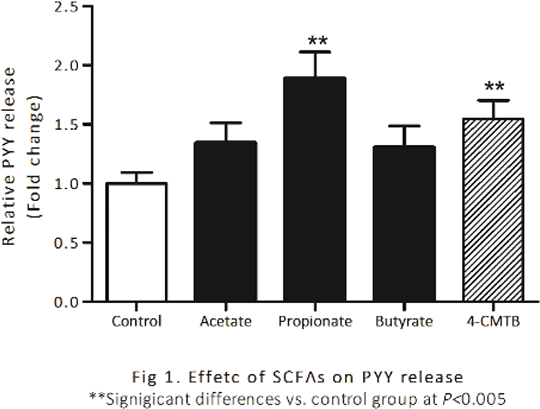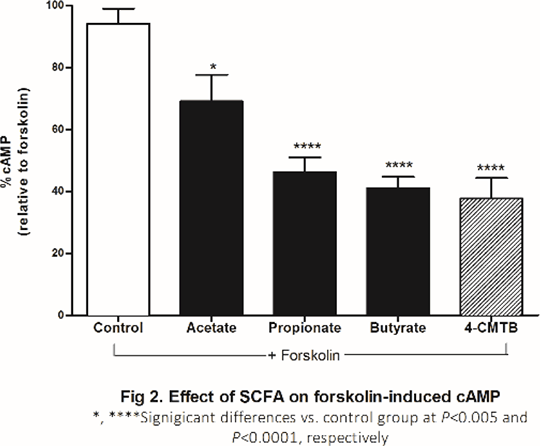Short chain fatty acids stimulate anorectic hormone release in colonic organoids Increased concentrations of short chain fatty acids (SCFAs), the major end products of dietary fiber fermentation by the colonic microbiota, improves energy homeostasis through the release of the anorectic hormones, peptide YY (PYY) and glucagon-like peptide-1 (GLP-1) (1). SCFAs mediate their effects via the G-protein coupled receptors free fatty acid receptor 2 and 3 (FFA2/3) (2), however the mechanisms underlying the activation of these receptors in the colon is not entirely known. The aim of this study was to determine the pathways involved in SCFA-induced gut hormone release. Colons (from below the cecum to the rectum) were obtained from adult male C57BL6. Crypts were isolated with EDTA and cultured into organoids, an in vitro 3D system that allows crypts to grow and continuously produce differentiated epithelial cells in a similar manner that will occur in vivo (3). After 4 days of differentiation, organoids were treated with acetate, propionate or butyrate (1mM), or the FFA2 specific allosteric ligand, 4-chloro-α-(1-methylethyl)-N-2-thiazolylbenzeneacetamide (4-CMTB) (10 µM) to assess PYY release (1 hour) and intracellular levels of cAMP (5 min). PYY release and intracellular content was assessed using an established in-house radioimmunoassay (4) and cAMP was measured using HTRF cAMP detection kit (CISBIO, France), in presence of the adenylyl cyclase activator, Forskolin (3 µM). Intracellular calcium levels were also measured using the Fluo-4 Direct Calcium Assay Kit (Invitrogen, UK). Data are given as mean ± SEM and statistical significance was calculated by unpaired Student’s t-test. Treatment with propionate or 4-CMTB in colonic organoids significantly stimulated PYY release (1.89±0.23 and 1.54±0.16–fold, respectively) (Fig. 1) and also inhibited forskolin- induced cAMP (44.91±5.11, and 33.21±5.63, respectively, vs. 94.69±3.33%) (Fig. 2). Acetate and butyrate inhibited forskolin-induced cAMP accumulation (69.10±8.48 and 41.11±3.62 vs. 94.69±3.33%) but had no significant effect on PYY release. SCFAs were not able to increase intracellular calcium levels.
In summary, we have established that SCFAs can activate Gαi-signalling but not Gαq in a 3D culture system. However, only propionate stimulates PYY suggesting the activation of other pathways in addition to Gαi-signalling. (1) Byrne CS et al. (2015) Int J Obes 39: 1331–1338. (2) Kuwara A. (2014) Front Endocrinol 5: 144. (3) Sato T et al. (2011).Gastroenterology 141: 1762–1772. (4) Adrian TE et al. (1985). Gastroenterology. 89: 1070–1077.
|



